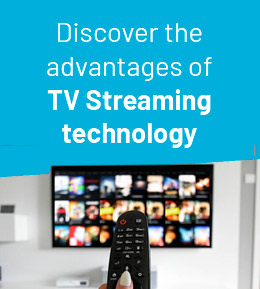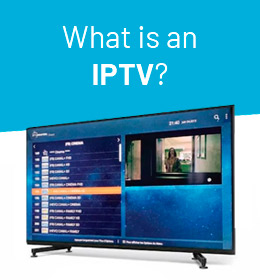IPTV has transformed the way we consume audiovisual content by harnessing the power of the Internet Protocol. From its inception as an alternative to traditional television to today, where it offers a wide range of entertainment and personalisation options, the technology behind IPTV has proven to be revolutionary. With each technological advancement, this form of media consumption continues to evolve, opening up new possibilities and enhancing our entertainment experience.

Contents
- 1 The Technology Behind IPTV: From Cable to Internet Protocol
- 2 The Technology Behind IPTV: From Cable to Internet Protocol
The Technology Behind IPTV: From Cable to Internet Protocol
Internet TV, also known as IPTV, has revolutionised the way we consume audiovisual content. Gone are the days when we were limited to traditional television channels transmitted through cables and antennas. Today, IPTV gives us a wide range of choice and flexibility in terms of what we want to watch and when we want to watch it. But how does this technology work and how has it evolved over the years?
In its early days, television was transmitted via designed or digital signals that were received by antennas or coaxial cables. However, with the growing popularity of the Internet, it became possible to transmit audiovisual content over the network. This paved the way for the advent of IPTV.
IPTV is based on the Internet Protocol (IP), which is the set of rules that enables communication and data transfer over the Internet. Instead of using physical cables or radio frequencies to transmit television signals, IPTV leverages the existing Internet infrastructure to send and receive video and audio data.
The Technology Behind IPTV: From Cable to Internet Protocol
Internet TV, also known as IPTV, has revolutionised the way we consume audiovisual content. Gone are the days when we were limited to traditional television channels transmitted through cables and antennas. Today, IPTV gives us a wide range of choice and flexibility in terms of what we want to watch and when we want to watch it. But how does this technology work and how has it evolved over the years?
In its early days, television was transmitted via designed or digital signals that were received by antennas or coaxial cables. However, with the growing popularity of the Internet, it became possible to transmit audiovisual content over the network. This paved the way for the advent of IPTV.
IPTV is based on the Internet Protocol (IP), which is the set of rules that enables communication and data transfer over the Internet. Instead of using physical cables or radio frequencies to transmit television signals, IPTV leverages the existing Internet infrastructure to send and receive video and audio data.

Streaming technology for watching TV
The process begins with the creation and encoding of audiovisual content in digital format. This content is divided into data packets and compressed to optimise transmission over the Internet. These data packets are then sent across the network using IP addresses, which identify the devices and locations to which the data should be sent.
Upon arrival at the destination, the data packets are reconstructed and decoded to recover the original video and audio signal. This is achieved through the use of codecs, which are compression and decompression algorithms that allow the data to be reduced in size without any perceptible loss of quality. Some of the common codecs used in IPTV include H.264, H.265 (also known as HEVC) and VP9.
IPTV also benefits from streaming technology, which allows continuous playback of content without the need to download it in its entirety before viewing. This means that users can start watching a movie, TV show or any other type of content immediately, without having to wait for it to download completely.
As the technology behind IPTV has advanced, concepts such as IPTV (Internet Protocol Television) and OTT (Over-the-Top) have also emerged. IPTV refers to the delivery of television content over private networks controlled by telecommunications operators, allowing them to offer interactive and personalised services. OTT, on the other hand, refers to the delivery of video content over the public Internet, allowing users to access services such as Netflix, Hulu and Amazon Prime Video.
Benefits of IPTV: Access to On-Demand Content and Personalisation
IPTV has brought a number of significant benefits. Access to on-demand content and the ability to personalise our viewing experience has changed the way we consume media. We are no longer tied to fixed schedules or to content that does not interest us. IPTV gives us the freedom to choose what to watch, when to watch it and how to tailor it to our individual tastes. This allows us to enjoy a more satisfying and personalised entertainment experience.
Access to on-demand TV programme content
One of the most outstanding advantages of IPTV is access to on-demand content. Unlike traditional television, where viewers are limited to channel broadcasting schedules, IPTV allows us to watch what we want, when we want. Through streaming platforms and video-on-demand services, such as Netflix, Amazon Prime Video and Hulu, we can choose from a wide variety of movies, series, documentaries and other content, and enjoy them at any time, without time restrictions. This gives us greater freedom and flexibility to organise our entertainment time.
Personalise TV to suit our tastes
In addition to access to on-demand content, IPTV also allows us to personalise our viewing experience. IPTV services offer personalised recommendations based on our tastes and preferences. They use artificial intelligence and machine learning algorithms to analyse our viewing history and provide us with relevant suggestions. This helps us discover new content that might interest us and saves us time by not having to manually search for each programme or movie.
Create individual profiles
IPTV allows us to create individual profiles for different members of the household. Each person can have their own profile with their own content preferences and personalised recommendations. This is especially enhanced in households with different tastes and ages, as each member can enjoy content tailored to their interests.
Pause, rewind, fast forward TV programmes
IPTV also offers the ability to pause, rewind and fast forward the content we are watching. We are no longer constrained by commercials or missing a crucial moment in the programme. We can pause playback, rewind if we missed something important or simply fast forward if we want to skip parts that don’t interest us.
High definition and 4K quality
In addition to these benefits, IPTV has also opened the door to the transmission of content in high definition and 4K quality, giving us a more immersive and high quality viewing experience. It has also encouraged the creation of original productions exclusive to broadcast platforms, giving us access to fresh and unique content.
The Television of the Future: Innovation and Experience with IPTV
IPTV has transformed the way we consume audiovisual content, and continues to evolve in leaps and bounds. As we move into the future, innovation in IPTV brings exciting new opportunities and experiences.
Improvements in Video and Sound Quality
One of the highlights of Future TV is the constant improvement in video and sound quality. Thanks to the increasing availability of high-speed connections and advances in video compression technology, such as the AV1 codec and H.265 codec, viewers can enjoy sharper resolution, more vibrant colours and finer detail. HDR (High Dynamic Range) technology also offers a wider dynamic range, which means greater colour reproduction and more intense contrasts. In addition, surround sound and Dolby Atmos technology provide an immersive audio experience that complements the visual quality.
Virtual Reality and Augmented Reality on Television
Future TV also brings us closer to the integration of virtual reality (VR) and augmented reality (AR) technologies into our viewing experience. With VR, viewers can fully immerse themselves in a virtual environment and enjoy a sense of presence. Augmented reality, on the other hand, can add virtual elements to the real world, allowing for a more immersive interaction with TV content. These technologies offer new forms of entertainment, from interactive gaming to more immersive viewing experiences.
Advanced Interaction and Personalisation
Future TV offers us greater interaction and personalisation. Advances in artificial intelligence and machine learning allow IPTV services to better understand our tastes and preferences, providing more accurate and relevant recommendations. In addition, voice assistants and gesture controls make it easier to interact with devices and navigate content. We can perform voice searches, change channels, adjust volume and control playback without the need for a traditional remote control. This allows for a smoother and more seamless experience.
Integration with Smart Devices and Connected Homes
Future TV integrates seamlessly with smart devices and connected homes. We can now control our IPTV through our mobile phones, tablets or smart speakers. In addition, IPTV can interact with other devices and home systems, such as smart lights, thermostats and security systems. We can create personalised scenes that synchronise lighting, weather and multimedia devices to create an immersive and personalised experience in our home.
Interactive and Engaging Content
Future TV also gives us the ability to interact and actively participate in the content we are watching. Through interactive platforms and integrated social networks, viewers can comment, share opinions and participate in real-time polls while watching TV programmes, sporting events or live broadcasts. This creates a more social experience and allows us to connect with other viewers around the world, offering real-time discussions and debates.
Future TV offers us a number of exciting innovations and enriching experiences. From improvements in video and sound quality to the integration of virtual and augmented reality technologies, IPTV continues to drive the evolution of entertainment. Advanced interaction and personalisation, integration with smart devices and connected homes, and interactive and participatory content are just some of the ways Future TV is transforming our viewing experience. We are witnessing an exciting shift in the way we enjoy audiovisual content, and IPTV is leading the way to a future full of innovation and new possibilities.







